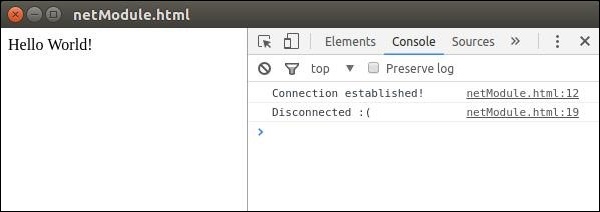- 电子包节点更新 - Javascript (1)
- 电子 (1)
- 电子包节点更新 - Javascript 代码示例
- 在本机反应中圈 - Javascript(1)
- 数字电子中的“或”门
- 数字电子中的“或”门(1)
- 电子 - 任何代码示例
- 电子-安装
- 电子-安装(1)
- 在本机反应中圈 - Javascript代码示例
- 电子检查 - Javascript (1)
- 电子示例问题 - Javascript (1)
- Java中的本机关键字
- Java中的本机关键字(1)
- 如何在 JavaScript 中获取值的本机类型?
- 电子下载 (1)
- 在本机反应中选择字段 - Javascript (1)
- 电子教程(1)
- 电子教程
- 电子检查 - Javascript 代码示例
- 电子 jquery - Javascript 代码示例
- 电子-资源
- 电子-资源(1)
- 在本机反应中选择字段 - Javascript 代码示例
- 讨论电子(1)
- 讨论电子
- 电子-概述
- 电子-概述(1)
- 电子.不工作 - Javascript (1)
📅 最后修改于: 2020-10-25 10:55:01 🧑 作者: Mango
在上一章中,我们使用了一个节点模块fs。现在,我们将介绍可与Electron一起使用的其他一些节点模块。
操作系统模块
使用OS模块,我们可以获得有关运行应用程序的系统的很多信息。以下是在创建应用程序时提供帮助的一些方法。这些方法可帮助我们根据正在运行的操作系统自定义应用程序。
| Sr.No | Function & Description |
|---|---|
| 1 |
os.userInfo([options]) The os.userInfo() method returns information about the currently effective user. This information can be used to personalize the application for the user even without explicitly asking for information. |
| 2 |
os.platform() The os.platform() method returns a string identifying the operating system platform. This can be used to customize the app according to the user OS. |
| 3 |
os.homedir() The os.homedir() method returns the home directory of the current user as a string. Generally, configs of all users reside in the home directory of the user. So this can be used for the same purpose for our app. |
| 4 |
os.arch() The os.arch() method returns a string identifying the operating system CPU architecture. This can be used when running on exotic architectures to adapt your application for that system. |
| 5 |
os.EOL A string constant defining the operating system-specific end-ofline marker. This should be used whenever ending lines in files on the host OS. |
使用相同的main.js文件和以下HTML文件,我们可以在屏幕上打印这些属性-
OS Module
现在使用以下命令运行应用程序-
$ electron ./main.js
上面的命令将生成以下输出-
User Info: {"uid":1000,"gid":1000,"username":"ayushgp","homedir":"/home/ayushgp",
"shell":"/usr/bin/zsh"}
Platform: linux
User home directory: /home/ayushgp
OS Architecture: x64
网络模块
net模块用于应用程序中与网络相关的工作。我们可以使用此模块创建服务器和套接字连接。通常,建议使用npm的包装器模块,而不是将net模块用于与网络相关的任务。
下表列出了模块中最有用的方法-
| Sr.No | Function & Description |
|---|---|
| 1 |
net.createServer([options][, connectionListener]) Creates a new TCP server. The connectionListener argument is automatically set as a listener for the ‘connection’ event. |
| 2 |
net.createConnection(options[, connectionListener]) A factory method, which returns a new ‘net.Socket’ and connects to the supplied address and port. |
| 3 |
net.Server.listen(port[, host][, backlog][, callback]) Begin accepting connections on the specified port and host. If the host is omitted, the server will accept connections directed to any IPv4 address. |
| 4 |
net.Server.close([callback]) Finally closed when all connections are ended and the server emits a ‘close’ event. |
| 5 |
net.Socket.connect(port[, host][, connectListener]) Opens the connection for a given socket. If port and host are given, then the socket will be opened as a TCP socket. |
网络模块也带有其他一些方法。要获得更全面的列表,请参阅此。
现在,让我们创建一个电子应用程序,该应用程序使用net模块创建与服务器的连接。我们将需要创建一个新文件server.js-
var net = require('net');
var server = net.createServer(function(connection) {
console.log('Client Connected');
connection.on('end', function() {
console.log('client disconnected');
});
connection.write('Hello World!\r\n');
connection.pipe(connection);
});
server.listen(8080, function() {
console.log('Server running on http://localhost:8080');
});
使用相同的main.js文件,将HTML文件替换为以下内容-
net Module
使用以下命令运行服务器-
$ node server.js
使用以下命令运行应用程序-
$ electron ./main.js
上面的命令将生成以下输出-

观察到我们会自动连接到服务器,并且也会自动断开连接。
我们还有其他一些节点模块,可以使用Electron在前端直接使用。这些模块的用法取决于您在其中使用的方案。